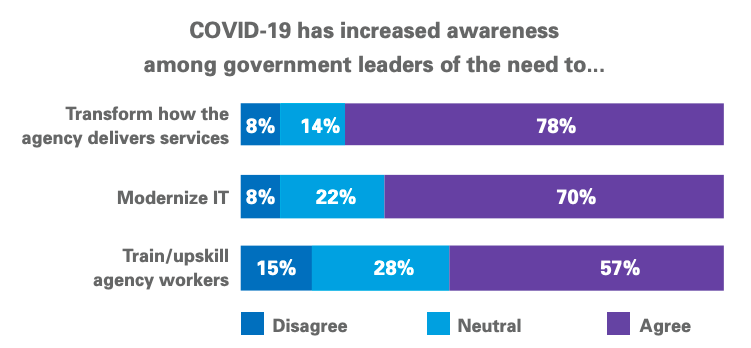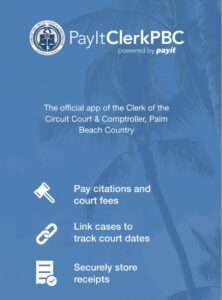In 2021, we continued to see state and local governments undertaking robust efforts to modernize their infrastructure, automate their workflows and improve the citizen experience.
Here are five key takeaways from this year in the public sector:
1. The pandemic has highlighted the value of government software systems
With the outbreak of the COVID-19 pandemic in 2020, agencies accelerated their digital government initiatives to enable their employees to work remotely and better serve the needs of their constituents. In 2021, we continued to see digital transformation trends in the public sector, with agencies increasing their technology investments to improve operational efficiency and service delivery.
Findings from The 2021 State CIO Survey — conducted by the National Association of State Chief Information Officers (NASCIO) — indicate that the pandemic has increased the awareness of the importance of digital technology in the public sector. More government leaders now see it as critical to business continuity and resilience.
A KPMG report also confirms that the pandemic has highlighted the value of digital transformation in government and the public sector, especially IT modernization and service delivery transformation initiatives.

Source: KPMG, Modern Government Report, 2021
2. Government digital transformation is here to stay
Investments in digital government transformation won’t stop with the pandemic, though. According to Deloitte‘s research, 75% of government leaders expect their organizations to change even more over the next five years.
Here are some changes that state government leaders expect to continue post-pandemic, based on the NASCIO survey:
- Increased focus on government digital services
- Investments in broadband adoption and expansion
- Investments in legacy modernization
- Expanded government cloud services/SaaS deployments
- Broader adoption of data analytics and automation
These trends suggest that more agencies are pursuing digital maturity. By modernizing their infrastructure and transforming service delivery, governments can:
- Improve the citizen experience
- Better secure systems and citizen data from growing cybersecurity threats
- Increase operational efficiency and resilience
3. Enhanced citizen engagement boosts online revenue
Governments are taking a page out of the private sector’s book and focusing more on customer satisfaction. The pandemic has changed citizen expectations, increased the use of digital channels and citizen self-service as well as the demand for digital services and payments.
In 2021, government digital transformation trends have also indicated a correlation between improved citizen experience and an increased offer of digital services and payments. For 74% of the respondents in the State CIO Survey, delivering a better online experience for constituents is the top reason to expand their agencies’ digital products.
State and local agencies have learned that, by improving citizen engagement, they can expand their revenues, too. Consider the example of PayItClerkPBC, the payment app of the Clerk of the Circuit Court & Comptroller of Palm Beach County, Florida.
Launched in 2019 in partnership with PayIt, this government app enables citizens to search for and pay citations and court fees — from any device, anytime and anywhere. Residents can also receive reminders for upcoming due dates and store digital receipts and document copies in a digital wallet app.

This all-in-one digital government platform brought convenience to citizens and a return on investment (ROI) to Palm Beach County, thanks to a 23% year-over-year increase in online revenue collected (H1 2021 vs. H1 2020).
4. Increased cybersecurity awareness in government IT
The SolarWinds breach, which affected numerous government agencies, stole headlines in late 2020. Still, it left valuable lessons for 2021, such as an increased awareness of cyber threats and vulnerabilities and a call for enhanced preventive measures.
For example, the U.S. government has taken unprecedented steps in 2021 to secure the nation’s critical infrastructure from cyberattacks. The White House published an executive order to improve the nation’s cybersecurity and protect government networks. In addition, the final package of the bipartisan Infrastructure Investment and Jobs Act directs about $1 billion to modernize and protect local, state and federal IT networks.
A particular focus of concern has been the rise of ransomware as the cyber threat of the year, with the House Committee on Oversight and Reform warning that “Ransomware-related transactions in 2021 will be higher than the previous 10 years combined.”
Ransomware is a type of malware that holds data or systems hostage. Attackers encrypt files and lock organizations out of their systems until a ransom is paid. Governments and NGOs are among the favored targets, accounting for 11% of the incidents, as per Microsoft report.
5. Need for scalability and data integration across silos drive government cloud platform adoption
Government cloud gained ground in 2021. However, as NASCIO’s CIO report points out, the adoption of cloud technologies by state agencies varies based on function, with increased move to the cloud in areas that need scalability and responsiveness.
Siloed, legacy systems and processes contribute to operational inefficiencies and security risks. Data integration across different departments can become a challenge when systems don’t communicate with each other. With workflow automation, governments can replace manual processes, standardize forms and processes across agencies and promote better department integration.
Agencies are turning to scalable cloud-based platforms like PayIt to help integrate GovTech services and share data across different departments. Gartner predicts that, by 2023, more than 80% of the government’s digital implementations that do not build on a software platform will fail to meet their objectives.
PayIt’s platform is natively built in the AWS GovCloud for increased security. It’s also a low-code solution, which enables a speedy rollout of new services thanks to seamless deployment. There has been increased adoption of this type of solution, with the global market for low-code development technologies set to grow 22.6% in 2021, reaching $13.8 billion, according to Gartner.
By deploying PayIt’s cloud-native government platform, governments can also streamline their operations. According to Forrester Consulting’s Total Economic Impact™ (TEI) study of deploying PayIt, the productivity gains of the IT staff are worth $629,326 over three years. That’s possible because PayIt takes over the effort to maintain the portal, enabling the IT personnel to focus on other value-added initiatives.
Make the shift to government as a platform with PayIt
In 2021, PayIt’s clients have continued to see the tremendous impact a government platform can have on their back-office processes and service delivery. If you want to scale your digital services and payments in 2022, get in touch with us. We’ll walk you through our software for government and demonstrate how we can tailor a product that meets your unique needs and requirements.
